By James Jorden
The Staatsoper Stuttgart may be called the cradle of Regietheater, or at least a cradle of Regietheater. Strong theatrical values have characterized this company from the opening of the theater in 1912 (the world premiere of Ariadne auf Naxos, helmed by megaregisseur Max Reinhardt) through the 1950s, when Wieland Wagner’s frequent projects there caused the house to be nicknamed “the Winter Bayreuth,” on through the future, as Jossi Wieler becomes intendant in the fall of 2011. In fact, it was specifically Stuttgart’s production of Parsifal (directed by Calixto Bieito) that motivated my recent “Regietournee,” and obviously I’ll have a lot to say about that event a little later. But first, I’d like to take at least a brief look at two other productions by this company that were playing in repertory around the March 20 Parsifal date.
The first was Carmen, March 19, with which I think I got off on the wrong foot. The production by Sebastian Nübling starts with quite a challenge to the audience: we are shown a shabby room, where a man, presumably Don José, is slumped in an armchair watching television. At his feet is, unconscious or dead, a beautiful woman in a silvery evening gown, and perched on the chair behind him is Slimer from Ghostbusters. Or at least that’s how this silent character’s costume struck me: a poison-green unitard and face-distorting mask.
This fellow, it turns out, is named “Surplus,” and if you read the program notes (or even if you don’t, because the concept isn’t so esoteric), he’s a sort of Jungian shadow to the hero (“Josés anderes und dunkleres Ich.”) I have to admit I took an almost instant dislike to Surplus because he is, after all, a mime, and, as everyone knows, it’s because of mimes that everyone now thinks clowns are scary.
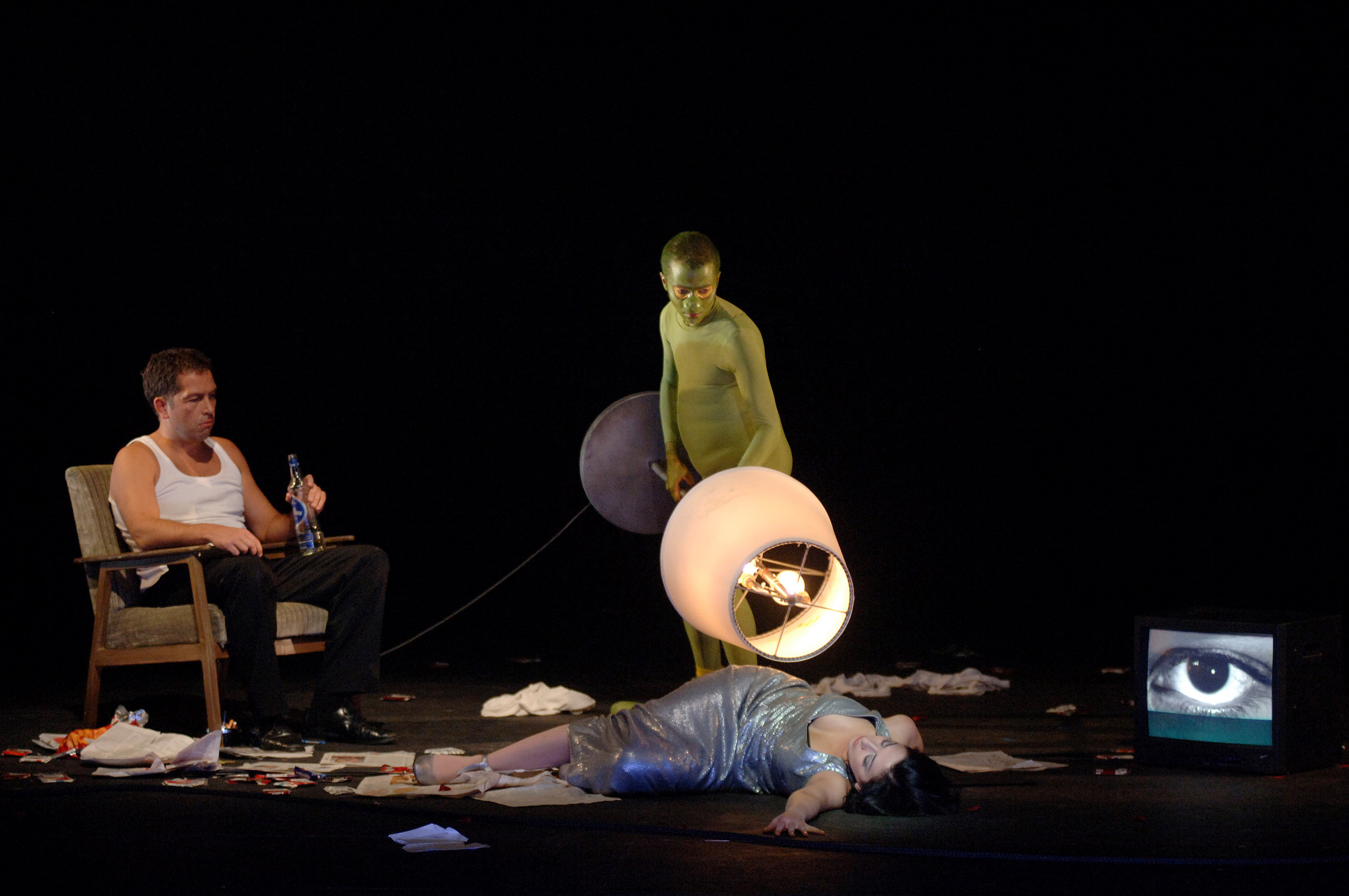
So, the action, as I was able to reconstruct it in retrospect during Micaela’s aria (the soprano, Michaela Schneider, was in poor voice, and I needed something to occupy my mind) goes something like this: José is this socially inept schlub, maybe a former soldier or maybe that’s just a story he tells, and his relationship with Carmen was sketchy or maybe even a product of his own imagination. The chorus tends to take on the character of whomever José is brooding about at the moment. For example, the children’s chorus are all dressed as mini-Carmens, which, given the leading lady’s 1930s glamour diva look in this production, makes “Avant la garde montante” look like a cattle call for Pal Joey at Stagedoor Manor. At various times, the general chorus takes on the appearance of José himself, MIcaela, Escamillo or (eventually) clowns in the same circus that Frasquita and her pals belong to. Yes, more clowns.
The action is so nonlinear that, even though Carmen starts the show already dead, she keeps coming back to life only to be snuffed continually by the soldier. He runs off to join the circus with her but, when Micaela fetches him to “rejoin his dying mother,” his return to bourgeois values takes the form of watching more TV with his girl back home. His thoughts wander, though, back to Carmen, leading to the climactic confrontation which ends unexpectedly (but logically) when the gypsy calmly lies down at his feet, “dead” again as at the beginning of the opera.
All this would have played better without the constant intrusive presence of Surplus, who, given nothing to sing, mugged and flailed and moved furniture around for three hours. I did like a bit when he did card tricks during the card trio, producing each card the girls were singing about and handing it off to them.
So, Surplus excepted, once the concept became clear, this wasn’t a bad way to do Carmen at all: avoiding the phony exoticism is always a good thing, and internalizing José’s rage meant that the opera ended not only with a surprise but with the troubling thought that he may have exorcised his obsession for the moment, but sooner or later he’s going to need to “kill” her again. There’s also the eminently practical point that because mimesis isn’t a top priority, nobody has to pretend to make eye contact, so everyone gets to sing straight out into the house most of the time.
Good old Surplus might have livened things up in a very dreary Lucia di Lammermoor on the 21st. About all that’s necessary to say is that this staging by Olga Motta would look right at home at Glimmerglass Opera, though to be sure even in such drab, predictable surroundings the chorus sang and acted like their lives depended on it. Do I need to tell you that the whole Mad Scene is played on the dinner table?
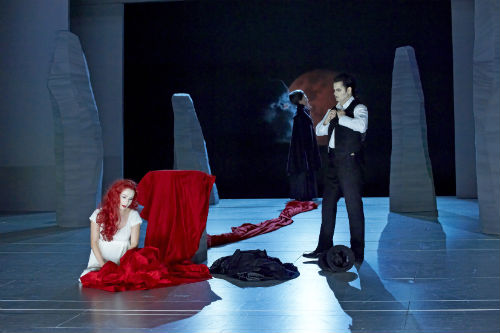
So, on to the main business of the day: Parsifal.
The first thing to note is that, yes, the epoch of the action is updated, but that detail is not the gimmicky cliche it usually has been in our time of “Cosi in the Roaring ’20s” and “Everything Jonathan Miller directs in Somerset circa 1912.” What Bieito does is to place the music drama in a post-apocalyptic not-too-distant future, a milieu as resonant and “mythical” to our own culture as the High Medieval was to the late Romantics. A ruined highway overpass dominates the left side of the stage, with a section of wrecked pavement seemingly broken across right at the curtain line (though the curtain is not used in this production). Thus an extra playing area of concrete and twisted steel projects over the orchestra pit also on the left side, with the still-standing section of highway towering above on pillars that vaguely suggest Romanesque columns.
To the right side of the stage are a few spindly trees so bare they might be abandoned telephone poles. The forest floor is littered with dead branches, and vaguely visible are several pits that might be manhole covers. To the extreme right is a small pond.
The action begins before the music starts: a tiny figure in hazmat gear and gasmask slowly clambers through the wreckage and finds a length of saffron-colored fabric. Once draped in the material, the figure begins a sort of prayer ritual, not so much a real prayer as a sort of experiment in how one might pray, or an attempt to remember what the act of prayer entails. It’s a bit of shock when we see that this is a woman (soprano Yuko Kakuta, one of the Knappen) which is a tipoff that the Grail “brotherhood” will be at least in part sexually integrated.
The prelude has started, “evoked” by the woman’s prayer, and slowly more figures appear through the fog and darkness that envelope the stage. Among them is a man with an axe who is half-heartedly whacking at the trees and examining the bark and a butch-looking woman with short hair lurking and observing. Then a naked pregnant woman walks on as if dazed, unaware of her surroundings. The short-haired woman offers her water from the pond, then gives her a jacket, which the naked woman distractedly lets drop before she wanders away.
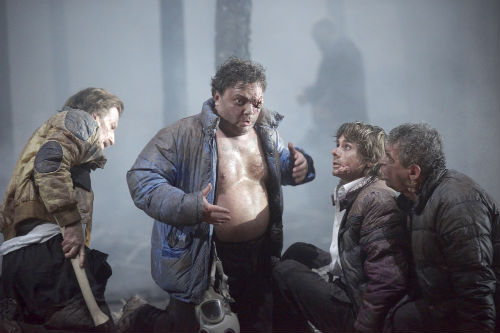
Meanwhile a phalanx of men assembles atop the overpass, in motley protective clothing, many of them disfigured with sores and even what appears to be conjoined fetus heads. The activity continues, slowly and without emphasis, and finally a man in a tattered suit arrives carrying a heavy backpack. This is Gurnemanz, and when he addresses the “Waldhüter,” it seems he is a stranger to at least some of them. Certainly he is not a leader in the expected sense: when he performs the morning prayer, some of the Knappen mock him and laugh at him.
Here is where Bieito takes the first big conceptual leap in this Parsifal, and to my mind the most exciting idea in the production, which is to make Gurnemanz an unreliable narrator. It’s not immediately obvious that he’s not (always) telling the truth, though the Knappen occasionally exchange quizzical looks. The line “Das wähnest du, der doch alles weiss?” strikes an interesting balance between irony and awe: the Ritter doesn’t seem quite sure whether Gurnemanz knows everything or nothing, or something in between.
This is all very subtle to start with, but it builds through the course of the first act as Gurnemanz gets more and more worked up by the narratives he’s relating to the followers. He gets so excited, in fact, that at one point he pulls out a pistol and hold his listeners captive. Shortly after, a bevy of altar boys appear, curiously clean and well-groomed, seemingly out of nowhere: it’s not immediately clear if they exist or (assuming they do) that we are seeing them through the distorted lens of Gurnemanz’ fanaticism. Or is their appearance a moment of magical realism? At this point, it’s hard to define.
It’s perhaps predictable that Kundry’s “Balsam” is a blister pack of pills she found in some abandoned pharmacy, but Bieito really works against our expectations with Amfortas. To begin with, the “sickly” king is by far the most robust looking character in the opera, the tall, buff baritone Gregg Baker. Far from being carried on a litter, Amfortas bizarrely is carrying a metal bathtub on his back (“Ein wenig Rast” is the least he deserves), but, strangest of all, there is no sign of a wound anywhere on his muscular bare torso. This, I think, is a very smart touch on Bieito’s part: an invisible (or psychosomatic) wound can be far more debilitating than one obvious to the world.
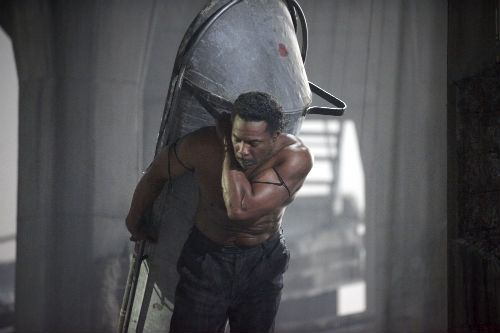
Eventually, as Gurnemanz whips himself into a frenzy over the machinations of Klingsor, he takes out his rage on the tiniest of the boys, stripping the lad to underpants and then swinging at him repeatedly with a leather belt. (The young actor was superb, flinching and then returning to his “at attention” attitude.) Finally the child drops dead and Gurnemanz curiously examines the blood seeping from his wounds, remarking “ein sel’ger Schimmer da entfloss dem Grale / ein heilig’ Traumgesicht / nun deutlich zu ihm spricht / durch hell erschauter Wortezeichen Mahle…” as if he were reading the entrails of a sacrifice.
His status as unreliable narrator is fixed solidly in the following scene, when Parsifal first appears. Bieito discards the scenario of the boy’s carelessly killing a swan; instead, Gurnemanz, guessing or hoping that this stranger might be “der reine Tor,” forces the issue. “You killed this innocent swan,” he lies to Parsifal, and the stranger (Andrew Richards) collapses with remorse as he embraces the child’s corpse, even trying to lick the blood from the wounds. A moment later, Gurnemanz gently pulls the dead body away and hands it off to the waiting knights, who take it upstage, hack it into chunks, and consume the precious animal protein.
And so the seed is planted here that the prophecy about the “reine Tor” is something less mystical than the way we have always perceived it. As the scene continues, Gurnemanz and Kundry both begin to pressure Parsifal to believe that he is the foretold one: in fact, Kundry’s violent emotional involvement in taunting the stranger seems to provoke a dissociative fugue state: she stops short, aware that something frightening is happening to her, slaps her face, but gradually realizes that whatever she is becoming cannot be resisted, and plods off in resignation.
But, back to Gurnemanz. How manipulative is he? Well, he feeds Parsifal some kind of hallucenogenic drug (mushrooms?) to get him in the optimally receptive mood for the Grail ceremony. This ritual turns out to be a bizarre parody of the Mass in consumerist terms: huckster Titurel and guilt-ridden Amfortas work the crowd up to the point of violence, and then toss them handfuls of mass-produced religious trinkets. For a few minutes, the crucifixes and menorahs and statues of Buddha give the throng some comfort, then seem to lose their potency and are discarded. The mob now holds up improvised placards that combine the functions of liturgical banners and picket signs. In a neat bit of symbolism, these banners are repurposed road signs: pleas for guidance and direction. Most prominent is the plaintive question “Wo ist Gott?”
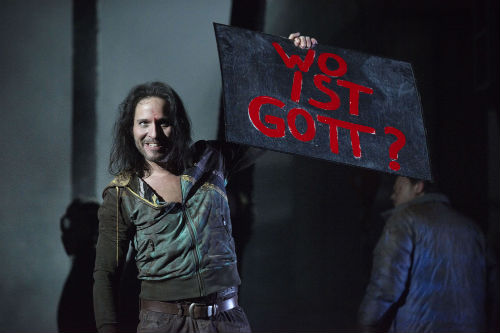
After confronting the audience with these demands for help and salvation, the men slink away, leaving behind Parsifal, so overwhelmed by this bizarre spectacle he is speechless. Disappointed and enraged, Gurnemanz heats up a branding iron and presses it into Parsifal’s bare chest (even providing a sound effect by drawing out the last hissing consonant of “und suche dir, Gänser, die Ganssss…”) leaving the boy so contorted in pain he is the only one who does not hear the comforting voice from above intoning “”Durch Mitleid wissend, der reine Tor!”
With the convention of the unreliable narrator already so well established, the second act of the music drama here makes rather more emotional sense than it generally does, though at the cost of some clarity in the moral debate that is also intrinsic to this act. We begin with Klingsor’s invocation of Kundry, a real coup de theatre with baritone Claudio Otelli striding about the forest clearing brandishing a working flamethrower. So nihilistic are both he and Kundry that they take turns dousing each other in gasoline and threatening each other with cigarette lighters, but her real advantage is tearing off his trousers exposing his crudely bound-up castration wound, duct tape holding together blood-stained boxer briefs.
Another spectacular effect happened a few minutes earlier, when Kundry awoke from her trance. This is particularly disquieting because she is actually asleep partially buried in a trench, so when Klingsor rouses her, he appears to be exhuming her reanimated corpse. Even though he is hardly in control of his own actions (he involuntarily humps the wall out of frustrated sexuality) he manages to work up her emotions to the desired tipping point, “invoking” the alter who will be his ally. As she did in the first act, Christiane Iven suggests this change of identities through a sudden release of physical tension into a relaxed, confident, but unfamiliar (to us) body posture. Klingsor hands her a few shopping bags with clothes to suit her new persona, but, unlike other productions of the music drama, he doesn’t leave the scene.
In fact, Klingsor is onstage observing and manipulating through the entirety of the act, first summoning and directing the Flower Maidens. Like Klingsor, they are physically damaged, their torsos bound up with plastic film and surgical tape, with open sores on their faces, and, incongruously wrapped up in ratty old fur coats. There is nothing conventionally seductive about them, and in fact the only association they have with flowers is that they obsessively scrawl floral designs on their bodies with lipstick.
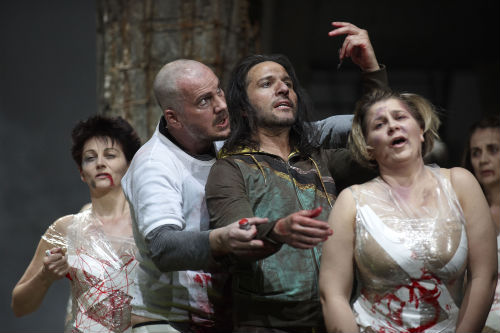
And yet Parsifal is enchanted, moving from wretched woman to woman, even roughly slicing the plastic off one of them, leaving her naked and bleeding. Kundry returns, now in a cheap 1970s dress and red wig, and, directed by Klingsor, she begins her seduction of the hero.
Again I marveled at how well completely unexpected and unorthodox stage action complemented the fixed text and music. It appears that Kundry’s plan during “Ich sah das Kind” is to regress Parsifal to early childhood, triggering his memory with a plastic toy tractor, and then offering him her breast to suckle. It’s not made explicit whether the trap Kundry is setting is the experience of incest or simply infantilization, but one idea that Bieito does seem to be aiming for is that the real sin cursing Amfortas, Kundry and Klingsor, and endangering Parsifal, is, for lack of a better way of putting it, a refusal to man up, to accept responsibility for one’s actions, instead of acting selfishly on sheer impulse. Amfortas’s sexual promiscuity is an symptom of that immaturity, but so is his unwillingness to stand up to his charlatan father.
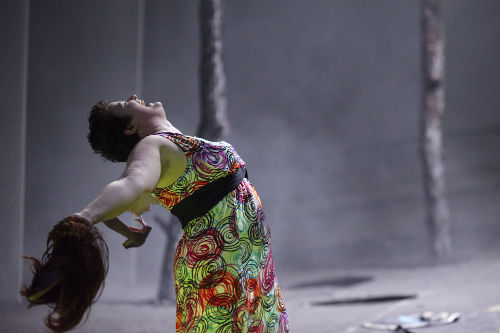
The action takes a wild turn toward the end of the act, when Parsifal begins haltingly to grasp the nature of salvation:
Doch wer erkennt ihn klar und hell,
des einz’gen Heiles wahren Quell?
Oh, Elend, aller Rettung Flucht!
Oh, Weltenwahns Umnachten:
in höchsten Heiles heisser Sucht
nach der Verdammnis Quell zu schmachten!
Instead of depicting his striving for enlightenment, Bieito shows the horrific result of his ignorance: for no obvious reason, Parsifal grabs a random Flower Maiden, slits her throat and then (concealed by the fallen pavement) proceeds to hack at her with his knife.
From this point to the end of the act, the blood flows unceasingly. As Kundry, once more hysterical, screams out her wild litany of “road” metaphors
Wehrt ihm die Wege!
Wehrt ihm die Pfade! –
Und flöhest du von hier und fändest
alle Wege der Welt,
den Weg, den du suchst,
des’ Pfade sollst du nicht finden:
denn Pfad und Wege,
die dich mir entführen,
so – verwünsch’ ich sie dir:
Irre! Irre…
Parsifal latches onto the idea of the Spear that wounded Amfortas, but, instead of reclaiming that specific relic from the thieving Klingsor, instead invents it anew from a scrap of rebar projecting from the wrecked overpass. This “spear” has no overt magic powers, but it does give Parsifal the advantage over Klingsor, impaling him with a great spurt of blood. This killing Bieito seems to regard as a passage into manhood for the boy; at any rate, Parsifal seems to stand taller and more confident as he snarls his last line directly to the audience: “Du weisst, wo du mich wiederfinden kannst!” Kundry, left alone, performs a definitive act of her own, cutting off her tongue.
The third act of Parsifal, for all its musical magnificence, is notoriously problematic to stage. The largest part of the drama has occurred, and there remains only Parsifal’s return to claim the leadership of the Grail brotherhood, one dramatic action in an act well over an hour long. And yet, even as exhausted as I always get by the third act of this work, Bieito’s take on the action kept my interest and emotional investment constantly engaged.
To begin with, the director invents a bit of symbolism that I think Wagner would kick himself for omitting: Gurnemanz is now literally blind, a sort of poetic justice for his inability to recognize Parsifal’s potential in the first act. As in that first act, there is some quiet stage action during the prelude: both Parsifal and Kundry quietly and wearily arrive on opposite sides of the stage, followed some minutes later by the sightless Gurnemanz. Thus they can observe how the old man’s pride has been chastened and even unwittingly spy on what he thinks is a private ritual when he produces a wicked-looking scourge built of rope and bicycle chains to mortify his flesh.
Gurnemanz discovers the others eventually, having to feel the mark of the brand on Parsifal’s chest to know him (“Erlösung,” the scar says) and finally recognizing Kundry when she guides his fingers into her maimed mouth. What he doesn’t see is that she is now heavily pregnant, and, a more subtle point, she seems now a different person from any of the alters we have beheld so far, suggesting that they may now be integrated successfully. Meanwhile, Parsifal unpacks his baggage, revealing the toy tractor, the Flower Maiden’s bloody bandages, and other mementos of his quest.
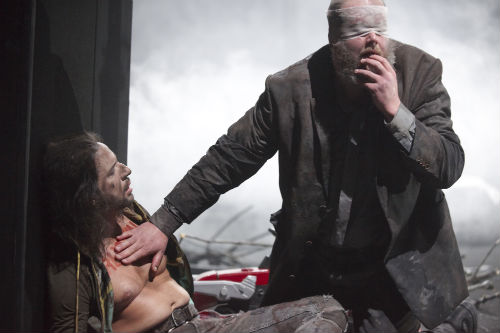
As soon as Parsifal’s mission is apparent (at the glorious orchestral outburst leading into “O Gnade! Höchstes Heil!” Kundry sets to work preparing the new leader for his office. Upstage is a supermarket shopping cart loaded with bags of stuff — at first suggesting Gurnemanz is homeless, but we soon see that what he’s been shlepping around is an elaborate set of vestments for the new Grail King, when, as, and if he arrives. Kundry dresses Parsifal in a robe trimmed with lace, an armored breastplate like something out of baroque opera, a feathery set of wings and even a Roman helmet. She further adorns him with a truly ecumenical set of religious symbols, hooking onto his sleeves and around his neck a menorah, a crucifix, a Qur’an, plus statues of the Virgin, Buddha, Shiva and even that latter-day deity Richard Wagner.
For the washing of Parsifal’s feet and (eventually) Kundry’s baptism, Gurnemanz produces bottled water– in a post-industrial world, surely more precious than diamonds. Parsifal especially lavishes it on Kundry, reminding us that even if we don’t accept the religious definition of baptism, we can be moved by its symbolic meaning, a cleansing in preparation for beginning anew.
Now, another unexpected and not immediately explicable touch. Gurnemanz has reached into his knapsack once more and swallowed some of the drug he fed Parsifal in the first act. With a sad and resigned look on his face, Parsifal remarks on the beauty of the meadow, though of course we can clearly see there is nothing there like the “Halme, Blüten und Blumen” he describes.
I may be wrong about this; there may be some completely different interpretation here, but what I got from this scene (the celebrated “Karfreitagszauber“) is that Parsifal is gently indulging Gurnemanz with a pleasant white lie, telling the blind man that, if he could but see, how beautiful the meadow would seem! Gurnemanz picks up on the suggestion so readily that from his imagination spring the choirboys from the first act, this time appearing in a blaze of light through the side doors of the theater, holding candles aloft. The image escapes being kitsch by virtue of its being a specific vision of a specific character: how blind, defeated Gurnemanz imagines “erlösten Menschen … der fühlt sich frei von Sündenlast und Grauen.”
What suggests to me that this interpretation is correct is that while Gurnemanz sings his solo, Parsifal gently embraces and caresses Kundry in a kindly, non-sexual manner. She stands in quiet ecstasy, accepting unconditional love, as rain drizzles down upon them. Thus Parsifal has not only learned compassion but lives it, intuting his companions’ deepest emotional needs and doing his best to meet them.
But there is more story here, some of it completely unexpected.
The main shocker is that, contrary to what Gurnemanz told us earlier, Titurel is not dead. Rather, he has become a sort of King Lear, childish of mind, wandering naked (an elderly body double takes over the role for this act) and scattering flowers while murmuring “Erlösung… Erlösung?” As the transitional music turns more dissonant and violent, Titurel is ambushed by disgruntled Grail knights and thrown into Amfortas’s metal tub, where they hack him to death with an axe and finally urinate on the corpse.
This is the “offering” they present Amfortas in an attempt to coerce him into performing the Grail ceremony one more time, and he even goes so far as to put on his murdered father’s signature sunglasses before finally refusing to take on the hated office. He sinks down at the feet of this father, weeping, as Parsifal appears, wheeling in on the shopping cart.
And then, as the saying goes, it gets really strange. After singing “Nur eine Waffe taugt,” Parsifal impales Amfortas with the spear, then scoops up a cupful of the dead king’s blood and drinks it. He flings more drops of the blood out over the heads of the assembled knights, and then… without any particular emphasis, raises up Titurel’s head, and the old man returns to life. Titurel then rouses Amfortas and the two, reborn, seem finally to connect. Amfortas leads his father away as Parsifal turns upstage and two of the knights strip off his robes, leaving the new Grail king naked. He kneels, then stands again as the congregants kneel and even prostrate themselves.
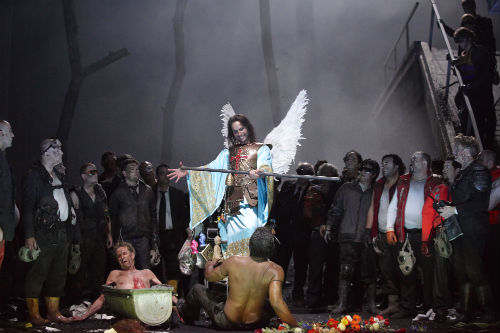
Parsifal climbs into the blood-drenched tub and is raised aloft by the congregants and borne offstage. Gurmemanz is led off by a couple of his choirboys, leaving behind only Kundry, her pregnancy a potent symbol of future hope. But any sense of the saccharine is banished as the plump, disheveled and clearly tuckered-out woman reaches into her shopping bag, pulls out tin of food, and sits alone, quietly munching with perhaps the hint of a smile, as the lights dim.
I realize I have been a lot more verbose this time around, but, frankly, I have in my life seen only a very few productions so dense and so challenging, yet so ultimately rewarding. I don’t think it’s an exaggeration to say that this Parsifal has changed my life. And any Parsifal that changes a life surely must be a Parsifal its creator would approve of.
Photos: Martin Sigmund (Parsifal), Sebastian Hoppe (Carmen), Thilo Nass (Lucia).
Tags: calixto bieito, gesamtkunstwerk, journey of a thousand miles, leather trench coats, parsifal, realism, regie, revivals, richard wagner, staatsoper stuttgart, symbols